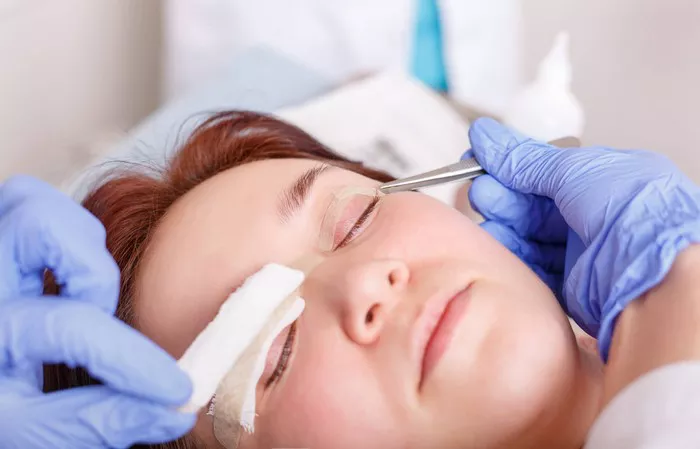Eyelid surgery, also known as blepharoplasty, is a popular cosmetic procedure aimed at rejuvenating the appearance of the eyelids. It addresses concerns such as sagging skin, excess fat, and puffiness in the upper and lower eyelids. If you’re considering eyelid surgery, it is natural to have concerns about the safety of the procedure. In this article, we will explore the safety of eyelid surgery, the potential risks and complications, and what individuals can do to ensure a safe and successful outcome.
Understanding Eyelid Surgery
Eyelid surgery, or blepharoplasty, is a surgical procedure that involves removing excess skin, fat, and muscle from the eyelids to create a more youthful and refreshed appearance. The surgery can be performed on the upper eyelids, lower eyelids, or both, depending on the individual’s needs and goals.
During the procedure, the surgeon makes discreet incisions along the natural creases of the eyelids. Through these incisions, excess tissue is removed or repositioned, and the surrounding muscles may be tightened. The incisions are then meticulously closed with sutures, resulting in minimal scarring that fades over time.
Blepharoplasty can address various aesthetic concerns, including droopy or hooded eyelids, under-eye bags, puffiness, and wrinkles around the eyes. The procedure aims to achieve a more alert, youthful, and rejuvenated appearance.
Safety of Eyelid Surgery
When performed by a skilled and experienced plastic surgeon, eyelid surgery is generally considered safe. However, like any surgical procedure, there are potential risks and complications that individuals should be aware of. It is essential to consult with a qualified surgeon who can evaluate your candidacy for the procedure, discuss potential risks, and guide you through the pre-operative and post-operative phases.
Here are some important considerations regarding the safety of eyelid surgery:
-
Choosing a Qualified Surgeon
The key to ensuring a safe eyelid surgery experience lies in choosing a qualified and experienced plastic surgeon. Look for a board-certified plastic surgeon who specializes in facial procedures, particularly blepharoplasty. A skilled surgeon will have the necessary training, expertise, and experience to perform the procedure safely and effectively.
-
Individual Evaluation
Before undergoing eyelid surgery, the surgeon will conduct a thorough evaluation of your overall health, medical history, and specific concerns. This evaluation helps determine your suitability for the procedure and identify any potential risk factors or contraindications.
-
Pre-operative Preparations
To enhance safety, the surgeon may request specific pre-operative preparations, such as avoiding certain medications or adjusting existing medical treatments. It is crucial to follow these instructions carefully to minimize any potential risks during the surgery.
-
Anesthesia
Eyelid surgery is typically performed under local anesthesia with sedation, ensuring that you are comfortable and relaxed throughout the procedure. The use of anesthesia is carefully monitored by an anesthesiologist or a qualified healthcare professional to ensure your safety and well-being.
-
Potential Risks and Complications
While complications are rare, they can occur in any surgical procedure. Potential risks associated with eyelid surgery may include infection, bleeding, scarring, asymmetry, changes in sensation, dry eyes, and difficulty closing the eyes completely. Your surgeon will discuss these risks with you and take necessary precautions to minimize them.
-
Recovery and Post-operative Care
Following the surgery, it is important to adhere to the post-operative instructions provided by your surgeon. This includes proper wound care, taking prescribed medications, attending follow-up appointments, and avoiding activities that could strain the eyes or hinder the healing process. Following the recommended guidelines will help ensure a smooth and safe recovery.
Minimizing Risks and Ensuring Safety
While eyelid surgery is generally safe, there are steps individuals can take to minimize risks and enhance their safety throughout the process:
-
Choose a Qualified Surgeon
Research and select a board-certified plastic surgeon with extensive experience in performing eyelid surgery. Read reviews, view before-and-after photos, and schedule consultations to evaluate the surgeon’s expertise and establish a rapport.
-
Open Communication
During your consultation, be open and honest with your surgeon. Discuss your medical history, current medications, and any concerns or questions you may have. Clear communication ensures that the surgeon has a comprehensive understanding of your needs and can tailor the procedure accordingly.
-
Follow Pre-operative Instructions
Adhere to the pre-operative instructions provided by your surgeon. This may involve avoiding certain medications, adjusting your diet, or stopping smoking if necessary. These instructions are designed to minimize any potential risks and optimize your safety during the procedure.
-
Full Disclosure of Medications and Supplements
Provide a complete list of all medications, supplements, and herbal remedies you are taking to your surgeon. Some medications and supplements can interfere with the surgical process or increase the risk of complications. It is essential to disclose this information to ensure your safety.
-
Prepare for the Recovery Period
Plan ahead for the recovery period by arranging for someone to drive you home after the surgery and ensuring you have the necessary supplies and support at home. Follow your surgeon’s post-operative instructions carefully, including any restrictions on activities and proper wound care.
-
Attend Follow-up Appointments
Attend all scheduled follow-up appointments with your surgeon to monitor your healing progress. These appointments allow the surgeon to assess your recovery, address any concerns, and make necessary adjustments to ensure a safe and satisfactory outcome.
Conclusion
Eyelid surgery, or blepharoplasty, is generally considered a safe procedure when performed by a qualified and experienced plastic surgeon. While risks and complications are rare, it is important to understand the potential risks, follow pre-operative and post-operative instructions, and choose a skilled surgeon. By taking these precautions and engaging in open communication with your surgeon, you can minimize risks and ensure a safe and successful eyelid surgery experience.


